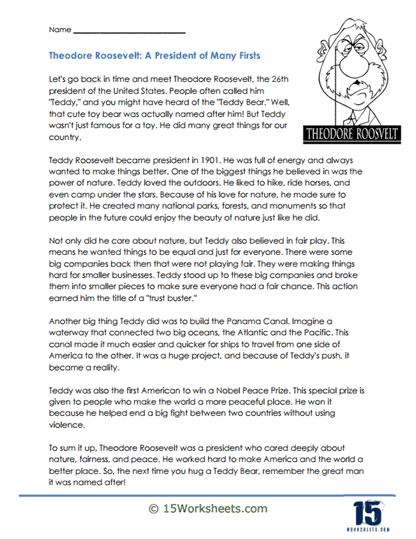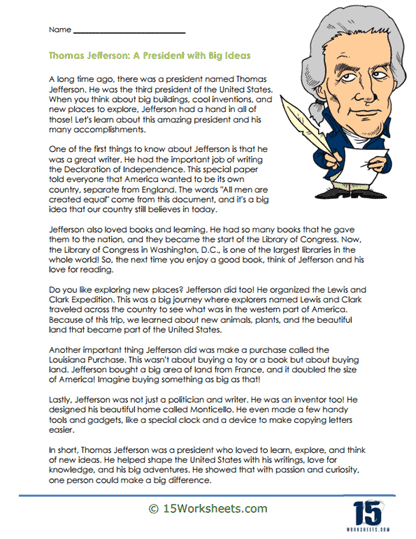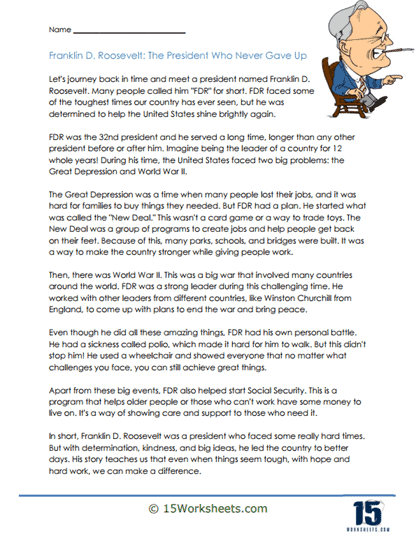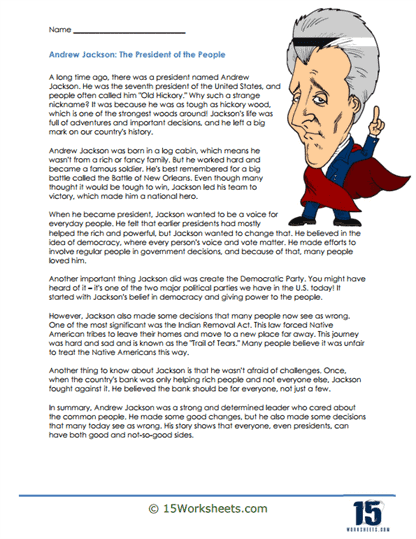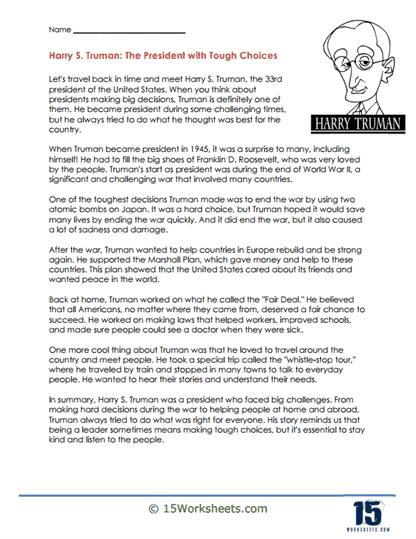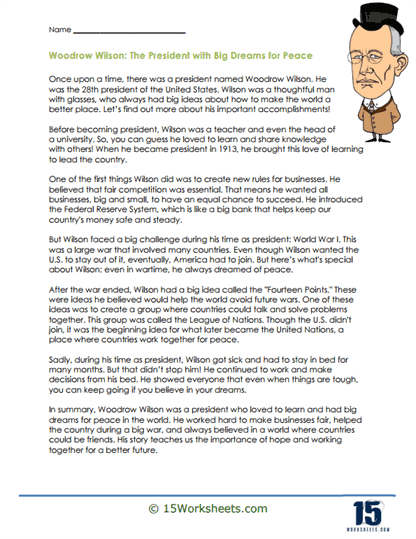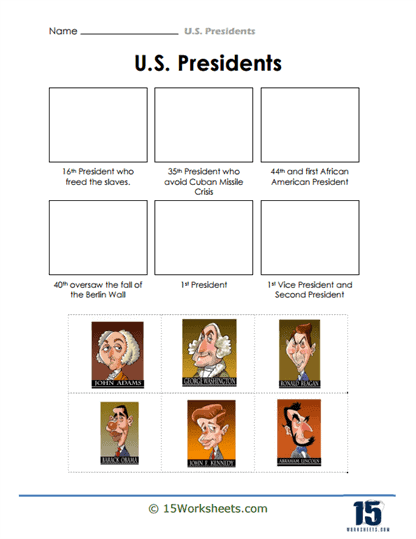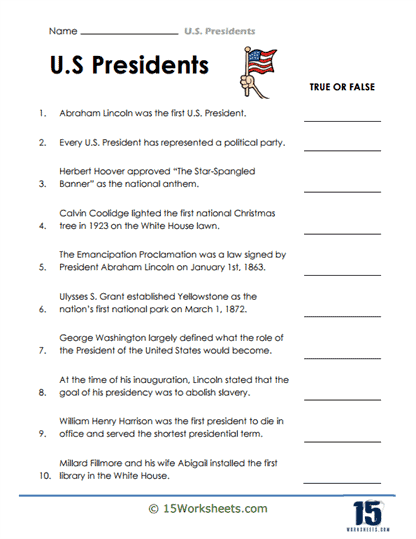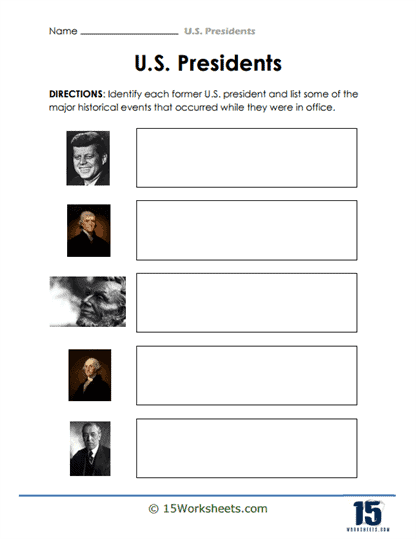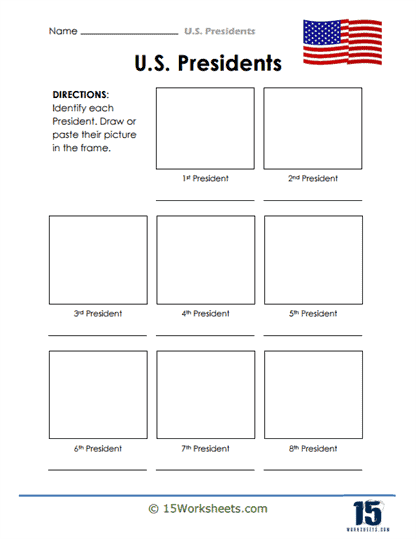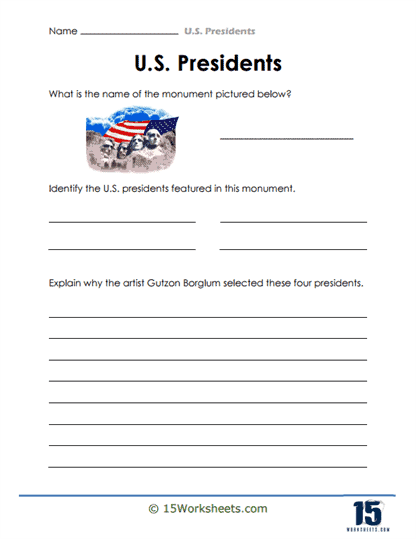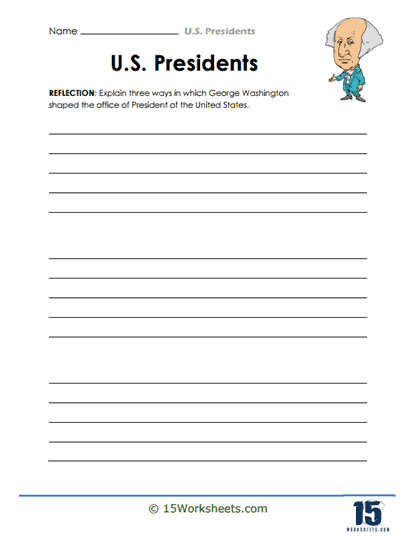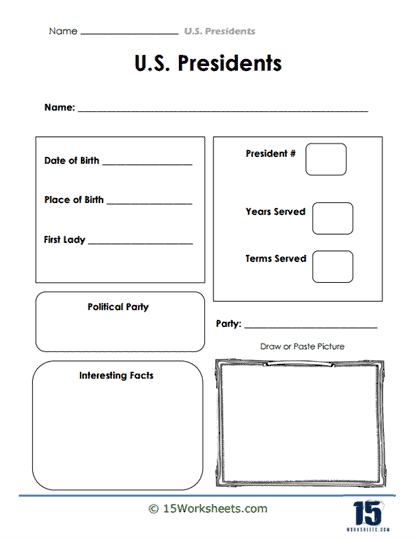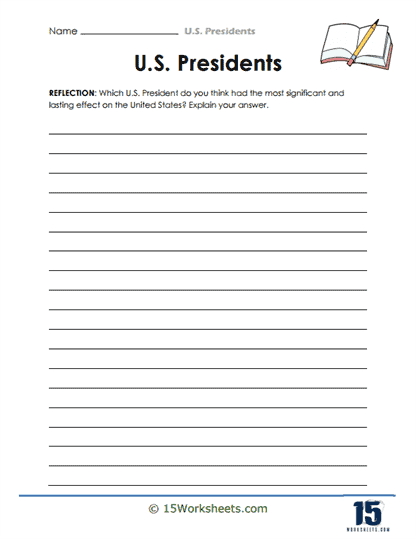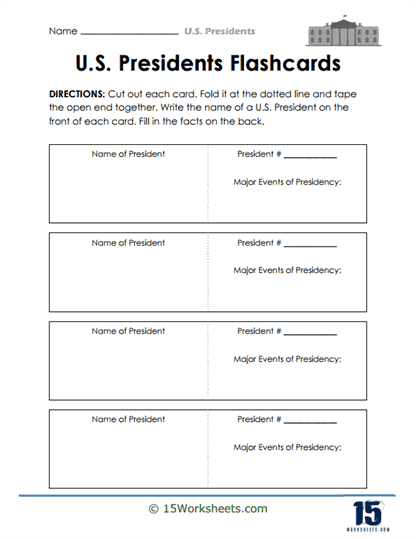American President Worksheets
About These 15 Worksheets
These worksheets will guide students on a deep and insightful journey through the lives and legacies of the individuals who have held the most powerful office in the United States: the presidency. With content that spans from the dawn of the nation’s founding, where George Washington laid the first stones of leadership, to the most recent administrations, these resources offer a comprehensive exploration of the triumphs, challenges, and pivotal moments that have defined each presidency. Far more than a simple recounting of dates and facts, these worksheets encourage students to engage critically with the stories of these men, probing into the unique qualities and historical forces that shaped their time in office.
The presidency of the United States is more than a position of governance; it is an institution that represents the hopes, dreams, and sometimes, the divisions of a diverse and dynamic nation. It is one of the most consequential and closely watched roles not only in America but across the world. Each president, from Washington to today, has carried the weight of their era’s most pressing issues, often standing as the central figure in both domestic and international affairs. Understanding the office of the president means understanding the evolution of the United States itself-how its ideals have been upheld, tested, and redefined through the centuries. These worksheets are designed to give students the tools they need to explore these complex narratives, helping them see beyond the surface of history and grasp the lasting impact of each leader’s decisions.
At the heart of this is the belief that by studying the lives of these presidents, students will gain a clearer understanding of the nation’s past and present. Each leader has faced unique circumstances, from the birth of a fragile new republic to moments of profound national strife like the Civil War, the Great Depression, and the civil rights movement. Other presidencies have been defined by war-whether the fight was for independence, for democracy in the world, or against ideological enemies during the Cold War. Still, others have grappled with social change, economic upheaval, and the growing influence of technology. By guiding students through these historical waters, these worksheets provide them with not only the facts but also the context, encouraging them to draw connections between the past and the world they live in today.
The aim is to make history come alive for students, showing them that presidents were not just distant figures locked in the pages of history books, but real people who made difficult choices in times of uncertainty. Each worksheet acts as a portal into the minds of these leaders, asking students to consider what it must have been like to sit in the Oval Office as a nation looked to them for guidance. For George Washington, it was the unprecedented task of defining the presidency itself. For Abraham Lincoln, it was the near-impossible task of holding a fractured nation together. For Franklin D. Roosevelt, it was the challenge of steering the country through not one, but two of the greatest crises in modern history: the Great Depression and World War II.
But the worksheets also delve into more modern presidencies, where the challenges of the 21st century-terrorism, economic inequality, environmental concerns, and the rapid pace of technological change-pose new and evolving questions about leadership and governance. These exercises do not shy away from examining the controversies and failures that have accompanied various administrations. By studying both the successes and the missteps, students are encouraged to think critically about leadership and what it means to wield power responsibly in a democratic society.
These worksheets foster a deeper understanding of the broader historical and political contexts in which these presidents operated. Students learn not just about the presidents themselves but about the eras they lived in-the ideologies, the social movements, and the international tensions that shaped their policies. By examining these factors, students are better equipped to appreciate how the presidency has evolved over time, adapting to the changing needs of the nation while staying tethered to the core principles of the Constitution.
One of the most important goals of this educational approach is to cultivate informed citizens. By gaining a thorough knowledge of the presidency, students develop a more nuanced understanding of American government and democracy itself. They are prompted to reflect on the role of the executive branch within the wider framework of checks and balances, and how each president has interpreted the powers and limitations of the office. This understanding is crucial, as many of the decisions made by presidents throughout history have had lasting impacts that continue to shape American society and the world at large.
These worksheets serve a purpose far greater than simply imparting knowledge-they seek to inspire the next generation of leaders, thinkers, and engaged citizens. By offering students the opportunity to learn from the past, these materials equip them to navigate the complexities of the future. The legacy of each U.S. president is not just a chapter in a textbook; it is a living, breathing part of the nation’s ongoing story. Through these carefully designed worksheets, students are invited to become part of that story, to reflect on what leadership means, and to consider how the lessons of the past can inform the challenges of tomorrow.
Types of Exercises On The Worksheets
Chronological Sequencing – Students may be asked to order presidents chronologically, fostering an understanding of the timeline of American leadership. This might involve matching presidents to their significant achievements, policies, or events during their tenure. For instance, linking Abraham Lincoln to the Emancipation Proclamation.
Multiple Choice and True/False Questions – These exercises assess foundational knowledge about individual presidents, their administrations, and major decisions or events related to their terms. Students could explore topics like the reasoning behind the Monroe Doctrine, the impact of FDR’s New Deal, or controversies surrounding more recent presidencies.
Comparative Analysis – This could involve comparing and contrasting the policies, challenges, or leadership styles of two or more presidents. Students might delve into inaugural addresses, presidential speeches, or personal letters, extracting themes, intentions, or sentiments.
Discussion and Debate Activities – Guided debates might revolve around decisions made by presidents, such as the dropping of atomic bombs in WWII or interventions in foreign conflicts. More comprehensive questions might ask students to discuss the evolving nature of the presidency, the impact of a specific president on American society, or the ethical dilemmas faced by certain leaders.
Biographical Sketches – Offering insights into personal backgrounds, students can examine the early lives, personal challenges, or character traits of various presidents.
Visual Analysis – Given the wealth of portraits, photographs, and media related to American presidents, students might analyze visual materials for insights into public perceptions, presidential image-crafting, or historical context.
The Value of These Worksheets For Students
The decisions, policies, and challenges faced by each president provide a lens through which students can understand the broader historical and societal shifts of their respective eras. By examining the presidency, students gain insights into the workings of American democracy, the balance of powers, and the evolution of executive authority over time.
Delving into the complexities and controversies surrounding certain presidencies promotes critical analysis, encouraging students to weigh multiple perspectives and form informed opinions. Presidents, with their diverse leadership styles, successes, and failures, offer valuable lessons in leadership, decision-making, and ethics.
A grasp of past presidencies aids students in understanding the present. Decisions made decades ago can have lasting impacts, influencing contemporary policies, international relations, or societal norms. An understanding of the presidency—and by extension, the government—equips students to be informed citizens, ready to engage in democratic processes and civic duties. Beyond politics, the lives of presidents can inspire. Stories of perseverance, dedication, or moral courage can resonate with students, offering both motivation and reflection.
While it’s essential to grasp the political and historical significance of each presidency, it’s equally crucial to draw lessons about governance, character, and societal impact. As students journey through the annals of American leadership, they not only gain an understanding of the past but also tools and perspectives to engage with the present and future.

